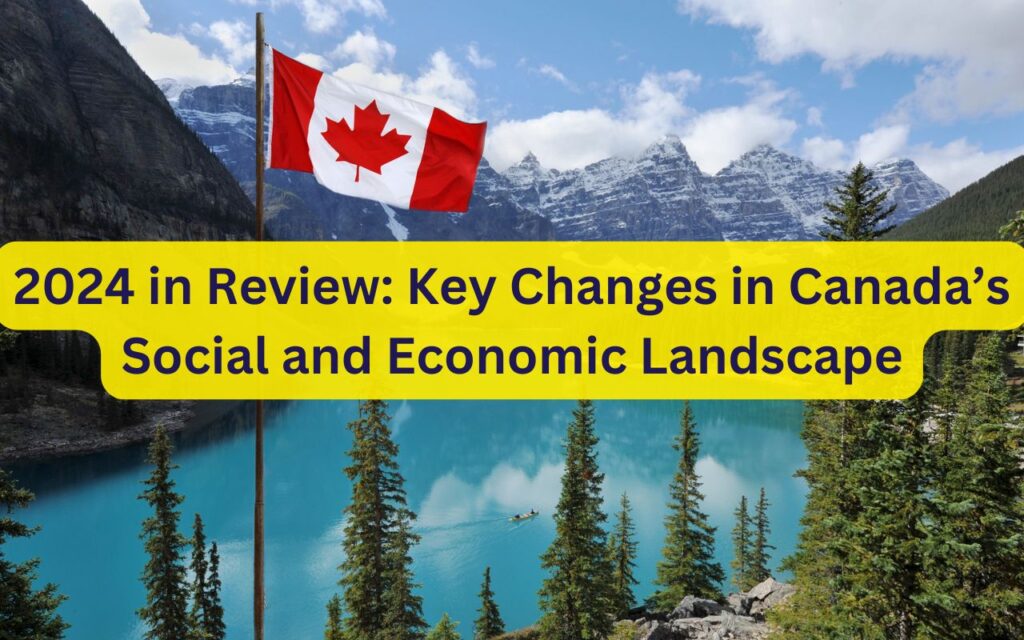2024 has been a groundbreaking period for Canada’s social and economic landscape, set apart by huge changes in government strategies, benefits programs, and economic patterns. These improvements have impacted many Canadians, shaping their financial prosperity, business open doors, and admittance to fundamental administrations. Key changes included alterations to tax breaks and social government assistance programs.
Like the Canada Child Benefit (CCB) and Old Age Security (OAS) and measures addressing inflation and housing moderation, the Canadian government has likewise centered around post-pandemic recuperation. Introducing arrangements pointed toward stabilizing the economy, creating the position, and addressing rising expenses of living. In this review, we will investigate the most significant changes and their suggestions for Canadians.
Key Changes in Canada’s social and economic landscape
2024 has been extraordinary for Canada, witnessing shifts in both Canada’s social and economic landscape. A few key changes denoted the year, affecting individuals, businesses, and the country all in all. As Canada continues to explore post-pandemic recuperation, ongoing worldwide economic tensions, and internal demands for change, 2024 stands out as a vital year.
From changes in social advantages to economic changes and environment-related strategies, the country’s landscape has developed. In this review, we will feature the significant changes and their expected long-haul influences.
| Title | 2024 in Review: Key Changes in Canada’s social and economic landscape |
| Department | Federal government |
| Country | Canada |
| Category | Policy Analysis |
| Official Website | canada.ca |

1. Social Change :- Canada Incapacity Advantage Execution
One of the main social changes in 2024 was the execution of the Canada Disability Benefit (CDB). Following quite a while of promotion and regulative postponements, the advantage was finally carried out to help Canadians with handicaps. Bill C-22, passed in 2023, established the groundwork for this significant change.
The CDB is intended to give financial help to working-age individuals with handicaps who face boundaries in accessing stable business. While the specific instalment sums shifted, the advantage means to connect the financial hole for this week populace.
The introduction of the CDB denoted a significant triumph for inability advocates. It gave direct financial help as well as featured the public authority’s obligation to address inequality. The program’s drawn-out progress, notwithstanding, relies upon its capacity to adjust to the varying requirements of beneficiaries.
2. GST/HST Credit Changes
2024 likewise saw massive changes to the GST/HST credit, which is a tax-exempt quarterly instalment intended to balance the deal’s charges paid by low-income individuals and families. These changes were important for the public authority’s more extensive technique to address inflationary tensions, which had been determined all through 2023.
The twofold GST credit given in 2023 was stretched out into 2024 to give transitory help to those most impacted by rising expenses of living. While the expansion was invited, many addressed whether these momentary measures could mitigate the more profound issue of rising inflation.
The changes additionally ignited banters around charge change and the public authority’s way of dealing with income inequality. However, the twofold GST credit helped many Canadians, and the year is finished with ongoing conversations about how to more readily target financial guidance.
3. Universal Basic Income Pilot Programs
A key economic discussion in 2024 spun around the Universal Basic Income (UBI) experimental runs programs. A few provinces, including Ontario and English Columbia, sent off limited-scope preliminaries to test the viability of UBI in reducing neediness and ensuring economic strength.
The experimental runs programs turned out a decent month-to-month revenue to members, paying little heed to business status, to measure its effect on work-seeking conduct, personal satisfaction, and financial security. Defenders contended that UBI could supplant obsolete government assistance frameworks and better locate the cutting-edge difficulties of underemployment and robotization.
While the consequences of these pilots are as yet pending, early reviews indicated a positive effect on financial security and psychological well-being for beneficiaries. Nonetheless, the significant expense of such projects remains a critical obstacle. The 2024 pilots are supposed to influence strategy choices in ongoing years as Canada wrestles with rising inequality.
- Canada’s Role in Global Climate Migration
- Electric Vehicles (EV) Revolution in Canada
- Canada’s Healthcare System
- Canada’s Immigration Pathways 2024
- Affordable Housing Crisis in Canada
4. Housing Crisis and Policy Shifts
The Canadian housing emergency, which had been brewing for quite a long time, turned out to be considerably more articulated in 2024. Skyrocketing home costs, particularly in metropolitan communities like Toronto and Vancouver, left numerous Canadians struggling to bear the cost of housing.
Accordingly, the central government executed a few strategy changes, including increasing funding for the Canada Housing Advantage. This advantage offers direct financial help to low-income leaseholders. While the action was useful, pundits contended that it did essentially nothing to address the main drivers of the housing emergency, for example, an absence of supply and hypothesis in the housing market.
To handle supply issues, the public authority additionally introduced zoning change initiatives and incentives for designers to fabricate reasonable housing. Notwithstanding, the consequences of these changes will probably require a very long time to emerge, leaving the housing market in a condition of uncertainty in the close term.
5. Economic Growth and Interest Rate Pressures
Canada’s economic presentation in 2024 was a hodgepodge. While there were times of development, the nation continued to feel the impacts of worldwide economic difficulties, especially in the type of inflation and rising interest rates.
The Bank of Canada raised interest rates a few times throughout the year in an endeavour to check inflation. Higher interest rates, notwithstanding, significantly affected the housing market, increasing home loan expenses and pushing numerous likely homebuyers out of the market.
Businesses likewise felt the strain of higher borrowing costs. Numerous private ventures revealed challenges in accessing reasonable credit, which hampered development and extension plans. Regardless of these difficulties, areas like innovation, efficient power energy, and medical care saw consistent development.
Canada’s social and economic landscape in 2024 highlighted the fragile equilibrium that policymakers should strike between controlling inflation and supporting economic development. As worldwide compels continue to shape Canada’s economy, finding that equilibrium remains a key test.
6. Climate Change and Green Energy Initiatives
In 2024, Canada continued its endeavors to battle environmental change and progress to a green economy. The national government multiplied its obligation to decrease fossil fuel byproducts, implementing stricter guidelines on industries and investing vigorously in sustainable power sources.
One of the year’s significant initiatives was the extension of the Canada Green Homes Grant. Which gave funding to property holders to make energy-productive moves up to their properties. This initiative added to reducing Canada’s carbon footprint as well as assisted property holders with lowering their energy bills.
Furthermore, the public authority figured out that petroleum derivative sponsorships, a move that was cheered by natural gatherings. Nonetheless, the change to a green economy has been challenging for certain industries, especially in oil-subordinate provinces like Alberta.
The pressure between economic interests and natural objectives was obvious all through 2024. While Canada took huge steps in efficient power energy, the progress has been slow and lopsided the nation over.
Conclusion
The year 2024 was an extended period of huge change for Canada as the nation continued to wrestle with social and economic difficulties. From significant social arrangement shifts like the execution of the Canada Handicap Advantage to ongoing battles in the housing business sector and medical services framework, 2024 featured the requirement for continued transformation and change.
| Homepage | uhmychart.org |
As Canada pushes ahead, the illustrations gained from this year will shape future approach choices. Whether addressing the housing emergency, environmental change, or economic inequality, the difficulties of 2024 have made way for additional adjustments in the years to come.
FAQs About Key Changes in Canada’s Social and Economic Landscape
The Canada Disability Benefit is a financial assistance program implemented in 2024 to support working-age Canadians with disabilities. It provides payments to help cover living expenses and reduce poverty among individuals who face barriers to stable employment.
In 2024, the GST/HST credit was extended with a temporary double payment to help low-income Canadians manage inflation. This initiative provided extra quarterly payments to offset rising costs.
Several provinces launched Universal Basic Income pilot programs in 2024, providing fixed monthly payments to participants. These programs aim to test UBI’s effectiveness in reducing poverty and improving financial security.
In 2024, the government increased funding for the Canada Housing Benefit and introduced zoning reforms to boost the affordable housing supply. However, the housing crisis remains a challenge due to rising prices and limited supply.
Canada increased immigration targets in 2024, aiming to welcome over 500,000 immigrants annually. This policy focuses on addressing labour shortages in key sectors like healthcare and technology through programs like the Provincial Nominee Program (PNP).
PV Martinez holds an MBA in Finance from the University of Michigan. When not analyzing numbers, PV enjoys playing football and spending time singing his favorite tunes.

